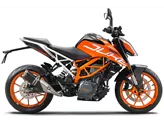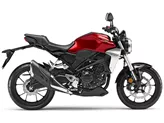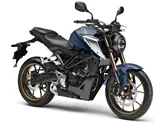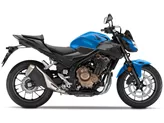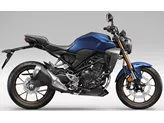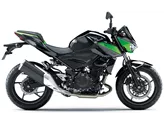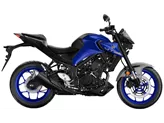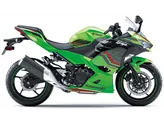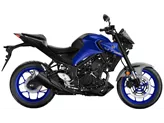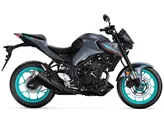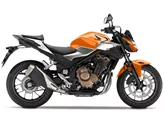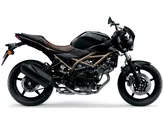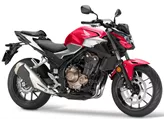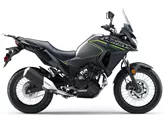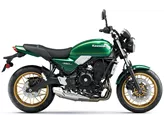Kawasaki Z 400 2019 vs. Honda CB300R 2018

Kawasaki Z 400 2019

Honda CB300R 2018
Overview - Kawasaki Z 400 2019 vs Honda CB300R 2018
The Kawasaki Z 400 2019 and the Honda CB300R 2018 are both popular naked bikes in their respective model years. While they have some similarities, there are also notable differences between the two.
In terms of engine power, the Kawasaki Z 400 2019 comes out on top with 45 HP, while the Honda CB300R 2018 lags behind with 31 HP. This means that the Z 400 offers more power and acceleration, making it a more thrilling ride for those who enjoy speed.
When it comes to torque, the Kawasaki Z 400 2019 also outperforms the Honda CB300R 2018 with 38 Nm compared to 27.5 Nm. This translates to better low-end grunt and more responsive acceleration on the Z 400.
Both bikes feature fuel injection systems, which provide efficient and precise fuel delivery. This results in improved fuel economy and smoother throttle response for both models.

Kawasaki Z 400 2019
In terms of cooling, both bikes utilize liquid cooling systems, which are more efficient at dissipating heat compared to air-cooled engines. This allows for better performance and reliability, especially during prolonged rides or in hot weather conditions.
In terms of suspension, both bikes feature swing arm rear suspension with monoshock absorbers. However, the Kawasaki Z 400 2019 comes with a telescopic fork front suspension, while the Honda CB300R 2018 boasts an upside-down telescopic fork front suspension. The upside-down fork on the CB300R provides better stability and improved handling, especially during aggressive riding.
Both bikes feature steel frames, which provide a good balance between rigidity and weight. However, the Kawasaki Z 400 2019 has a tubular frame, while the Honda CB300R 2018 features a twin-tube frame. The twin-tube frame on the CB300R offers better torsional rigidity, resulting in improved stability and handling.
In terms of braking, both bikes come equipped with single disc brakes on the front. However, there are some differences in the specifications. The Kawasaki Z 400 2019 has a larger front brake disc diameter of 310 mm, compared to the 296 mm on the Honda CB300R 2018. Additionally, the Z 400 features double piston calipers, while the CB300R comes with four piston calipers. These differences may result in variations in braking performance and feel.

Honda CB300R 2018
Both bikes are equipped with ABS, which enhances safety by preventing wheel lock-up during braking. This is an important feature, especially for novice riders or in emergency situations.
In terms of dimensions and weights, the Kawasaki Z 400 2019 has a slightly longer wheelbase of 1370 mm, compared to the 1352 mm on the Honda CB300R 2018. The Z 400 also has a lower seat height of 785 mm, making it more accessible for riders with shorter inseams. However, the CB300R has a lighter kerb weight of 143 kg, compared to the 167 kg of the Z 400. This lighter weight may result in improved maneuverability and agility for the CB300R.
Lastly, the Kawasaki Z 400 2019 has a larger fuel tank capacity of 14 liters, compared to the 10 liters on the Honda CB300R 2018. This means that the Z 400 can cover longer distances without the need for frequent refueling.
In summary, the Kawasaki Z 400 2019 offers more power, torque, and a lower seat height compared to the Honda CB300R 2018. However, the CB300R boasts smoother handling, better build quality, and advanced features such as IMU-ABS and full LED lighting. Ultimately, the choice between the two will depend on individual preferences and priorities.
Technical Specifications Kawasaki Z 400 2019 compared to Honda CB300R 2018
Pros and Cons in comparison
Pros and Cons in comparison
Kawasaki Z 400 2019

The Kawasaki Z400 is definitely a great evolution of its predecessor, the Z300. More power, less weight - all around, simply an even better bike. Above all, the linear power delivery and excellent handling make the Z400 an ideal entry-level bike. The ease of clutch operation and good chassis set-up are also in this vein, which is why the Z400 can be recommended to novice riders without hesitation.
Honda CB300R 2018

The somewhat hackneyed saying "Performance isn't everything!" hits the mark with the new Honda CB300R. The bike could be sold as the epitome of lightness, both in terms of weight and handling. The high build quality in combination with the successful styling will certainly help to overlook the less than complete equipment. Thus, the CB300R represents a real enrichment for the A2 segment!
Price Comparison Avarage Market Price Kawasaki Z 400 vs Honda CB300R
There are a few key differences between a Kawasaki Z 400 2019 and a Honda CB300R 2018. There are the same number of bikes of both models available on the 1000PS.de marketplace, specifically 6. It takes less time to sell a Kawasaki Z 400 with 99 days compared to 140 days for a Honda CB300R. Since model year 2019 1000PS.de editors have written 8 reviews for the Kawasaki Z 400 and 6 reviews for the Honda CB300R since model year 2018. The first review for the Kawasaki Z 400 was published on 10/2/2018 and now has more than 23,200 views. This compares to more than 36,500 views for the first review on Honda CB300R published on 11/6/2017.



